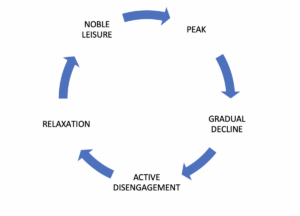Do you find yourself letting out a whoop of joy every time a meeting gets cancelled? Or smiling at a slow email day? I know I do. Ever since I started working from home, I find myself hitting disengagement at an increased pace. I know I am not the only one. It is no wonder that new terms like dopamine fasting and rest ethics are making their way into everyday vocabulary at an increased pace. However, before we start looking for solutions, it is important to analyze the problem a little more closely. What does the cycle of engagement look like and why is it spinning out of control?

Engagement with almost anything in life especially work undergoes five stages. Let’s call this peak, gradual decline, active disengagement, relaxation, and noble leisure. An individual goes through all five stages at varying frequencies. Peak describes the ideal state where one is in a state of flow, enjoys the activity and willingly engages with more of it. As much as we’d like to stay in that state, it is inevitably going to shift to gradual decline where while engaged, the mind tends to wander and work takes a little more effort that before. Given a choice, an individual will still choose voluntarily to engage with a task. This is followed by a period of active disengagement where voluntary engagement disappears and is replaced by the need to engage in an alternate task or nothing at all. Individuals at this stage find themselves repelled by the thought of attending another meeting or responding to emails. This is followed by a period of relaxation which allows one to recover from the stages that came before. Noble Leisure, a term coined by Aristotle is a stage where one moves beyond relaxation into engagement with a passion project or an activity that brings meaning and joy. When in noble leisure one achieves a state of flow in a task that is completely separate from the day job. It is in this stage that creative ideas begin to flow and imagination reignites thus preparing one to re-enter peak.
Every single individual goes through these stages at varying intervals throughout their work life. On an everyday basis, an activity such as sleep allows one to disengage and re-enter peak. These microcycles are supplemented with mini-cycles of short breaks spanning 1-2 days (often the weekend) that helps keep the microcycle functional. Once or twice a year, the period spent in noble leisure increases so as to keep the smaller cycles functioning. This could be a one or two-week break to travel, meet family, explore new places, a mindfulness retreat or even a staycation. All of these frequencies put together allows one to cruise through without a complete breakdown. Tending to these cycles also helps increase the number of days spent in peak and gradual decline. A close observation of individual activities will tell you exactly who is in which stage.
As we draw closer to 100 days of being in lockdown, a disturbing truth is emerging. The cycle time is dropping and the period of gradual decline has been replaced by rapid decline. Time spent in noble leisure has also come under threat. With shifts in lifestyle, employees (including me) are struggling to keep their cycle of engagement from spinning out of control. One doesn’t need to venture into a complicated root cause analysis to understand why. Not tending to each stage in the cycle causes it to swirl at unmanageable speed. People are finding themselves working for far longer hours, and vacation days have disappeared into oblivion. Add to that the woes of mental health and working under constant ambiguity, suddenly no one is surprised. It is but obvious that we would landslide into rapid disengagement.
So, how does one bring the cycle back to balance?
The same ingredients that aid mental health are the ones that allow for a healthy cycle time. It starts with understanding how you flow through the cycle of engagement, identifying which stage you are currently at and furiously guarding time spent in relaxation and noble leisure. Recapture the micro, mini and larger cycles. Once you actively start working through each stage, you will find yourself exercising greater control on peak and bringing back the rapid decline back to gradual. The key is not to force yourself to spend longer at one stage but to effortlessly cruise through all five and find yourself back at peak. All it takes is a little intention.
What are you going to do today to protect your cycle?
This article is exclusive to The Business Transformation Network.





